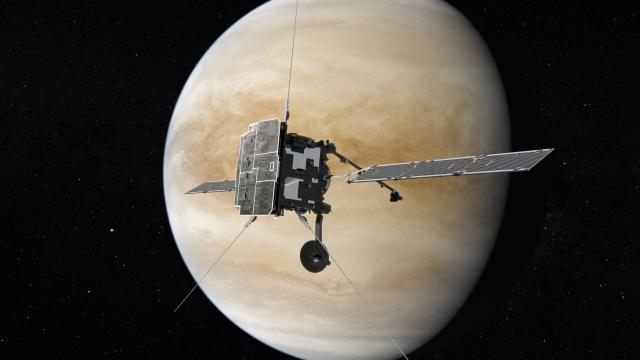Two spacecraft will fly past either side of Venus next week in the span of just 33 hours. The rare double flyby gives researchers an opportunity to observe the planet from multiple vantage points at nearly the same time.
The two vehicles are the Solar Orbiter and the BepiColombo Mercury mission. The former is a European Space Agency collaboration with NASA and the latter is an ESA collaboration with the Japanese space agency, JAXA. The two spacecraft will fly by Venus on August 9 and 10, respectively, with the Solar Orbiter passing from a distance of about 8,047 km and BepiColombo practically grazing the planet at just 563 km away.
I know what you’re thinking. One of these orbiters is clearly focused on the Sun, and the other on Mercury. What gives? Why are they messing with Venus? Well, both spacecraft are relying on gravity assists to get to their final destinations in the solar system. Gravity assists are when spacecraft use the gravitational fields of cosmic objects to slingshot into a new trajectory, saving fuel.
Conveniently, the assists require spacecraft to get relatively near those objects, giving researchers on Earth some bonus data. The Solar Orbiter has been zipping through these gravity assists since last year; it’s scheduled to make a total of six, five of which are Venus flybys. BepiColombo made one Earth flyby in April 2020 and a Venus flyby last October, and is scheduled to make six flybys of Mercury by 2025.
During the flyby next week, neither craft will be able to image Venus in high-resolution with their science cameras, according to an ESA press release. The Solar Orbiter will need to stay focused on — you guessed it — the Sun, and BepiColombo’s main camera is ensconced in the craft’s transfer module. But two of BepiColombo’s monitoring cameras will take some black-and-white shots as it approaches and passes Venus. Those images are expected to arrive on Earth within 24 hours after they’re taken. The Solar Orbiter’s SoloHI imager might be able to check out Venus’ nightside.
BepiColombo will see Mercury for the first time in early October, and the Solar Orbiter will make its final pass by Earth in late November. The data from the upcoming Venus flybys could eventually be of use to the ESA’s EnVision orbiter, set to launch for Venus in the early 2030s. Even after the Solar Orbiter finishes visiting Earth, it’ll routinely swing by Venus, which will help it get into position to better view the Sun. In the meantime, keep your fingers crossed we get some neat pictures from these spacecraft next week.
